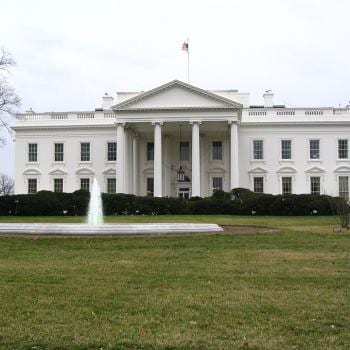Back in 1994, when the new Clinton administration system was trying to reform the healthcare system, a group of Republicans came up with an alternative, one more conservative and incremental. This effort is very similar to today’s Senate bill. Let me post a hypothetical – assume that the moderate Republican bill of 1994 has formed the basis of compromise. Let’s assume further that the same restrictions on abortion coverage as in today’s Senate bill were built into this compromise bill. Would have the pro-life movement have opposed this bill with the same vehemence they oppose it today? I do not think so.
Today, the pro-life movement is automatically inclined to view any Democratic initiative in this area through the “hermeneutic of suspicion”, always assuming bad motives, and always seeking hidden traps and pitfalls. Some of this boils down to nothing more than distrusting Obama and his friends, assuming they have a nefarious pro-abortion agenda hidden deep in the arcane code of a healthcare bill. But the pro-life movement, dominated by the NRLC, is smarter than that. They go through the language carefully, but with the same instinctive suspicion. After all, the NRLC explicitly supports Republicans, so is not exactly a credible source.
Consider the events of the past year. The first major pro-life lightening rod was the public option. Since this would be a healthcare program run by the government, it should be completely prohibited from tangling with abortion. The fact that such a public option would be fully funded by private premiums did not lessen the argument. At this time, noting that federal subsidies should not used to purchase private insurance plans that might include abortion warranted a mere couple of lines. It was a side argument.
But when the public option faded, it quickly became the central argument, and the Stupak provisions in the healthcare bill were seen as the only way to build an effective bulwark against abortion. But of course these provisions were not the only way. In the end, when it comes to protecting federal subsidies from being used for abortion, the Health and Senate bills do not differ much. In the House bill, if you want abortion coverage, you must purchase a supplemental policy. In the Senate bill, you must pay for a supplemental premium in the same policy, which must cover the gross costs of abortion, and must be subject to strict audit rules. As Sr. Carol Keehan of the Catholic Health Association notes, no federal dollars will be used to pay for abortions.
Still, having tied themselves too closely to the Stupak approach, the pro-life lobby maintained its maximalist stance over an issue of second-order distinction (after all, we are talking about a separate piece of paper). But yet again, the focus shifted. Now the main issue became the requirement for everybody who chooses a plan that includes abortion to pay the supplemental premium. There is a point here – the House bill is cleaner, and nobody is forced to pay for abortion in any plan. But the goal posts have shifted! What started as a campaign to stop federal funding of abortion in government programs switched to opposing any federal money being used to pay for a private plan that might include abortion, and then shifted again to the insured having no choice but to pay premiums to cover abortion.
I’m actually glad this has become an issue. I’ve been saying from the beginning that there is no moral distinction between a decision to collectively fund a health insurance program that includes abortion through private premiums or taxpayer funds. I would like to see the day when no health insurance plan anywhere funds an act that is not part of healthcare. But this really takes us beyond the parameters of the current debate. After all, the vast majority of people get health insurance through their employers, and nobody is able to opt out if the plan includes abortion (and most plans do). In fact, the people on the exchanges are in far better positions, as the Senate bill specifically calls for at least one plan not to offer abortion (including to those without subsidies, which is stronger language than the House bill). And given the focus that the separate checks would place on abortion, I would bet that the vast majority of plans on the exchange will not bother offering abortion. Imagine if all employer-based plans were forced to distinguish between the abortion and non-abortion premiums too? What would happen? I guess there would be uproar.
When it comes to the hermeneutic of suspicion, the focus on the community health centers really goes too far. If you go through any complex legislation with a fine tooth comb looking for loopholes, you will surely find them. And here, this looks like a loophole. The Senate bill creates a new Community Health Center fund and appropriates $7 billion. Aha! These funds are actually appropriated by the bill and so are not affected by the Hyde amendment that pertains to funds appropriated by Health and Human Services (HHS). Not so fast. For these centers are not in the abortion business to start with, and the money will be co-mingled with existing funds already appropriated by HHS (there is no provision for segregation of funds). Here is a statement released by the National Association of Community Health Centers:
“Existing Health Centers, funded by Section 330 of the PHS Act (also called Federally-qualified health centers, or FQHCs), do not provide abortions to any of their patients, and we are not aware of any that have ever done so. Health Centers do not plan to, nor are they seeking to, become providers of abortion. On the contrary, last year health centers provided prenatal, perinatal, and post-natal/post-partum care to 1 of every 8 children born in the U.S.
Given that both the new Community Health Center Fund dollars and current annual appropriations funding will be used in combination by HHS to fund Health Centers, we would expect that the current “Hyde” prohibition would continue to apply to all Health Centers and their operations.”
Since its creation 45 years ago, the Community Health Centers program has focused on bringing health care to millions of people in thousands of communities across the country that lack access to primary and preventive health care. This is especially true in low-income, un- and under-insured, and minority populations, and residents of rural and frontier communities with too few providers to serve them. The Senate health reform legislation’s Community Health Center Fund will allow Health Centers to expand to serve nearly 15 million new patients in communities across the country that still lack adequate health resources.
In other words, these seems like a perfectly fine pro-life initiative, if not viewed under the hermeneutic of suspicion.
As I noted before, the pro-life industry – dominated as it is by the staunchly Republican NRLC – takes a different tack when evaluating Republican healthcare initiatives. There, there pro-life standards are distinctly lower. Ironically, one commonality between the Health and Senate bills is that both prohibit discrimination against insurers who refuse to carry abortion. This is considered uncontroversial – all sides agree on what this says and means. Nobody on the pro-life side thinks it is nearly enough. But here’s the funny thing – this is exactly the language in the bill appropriating Medicare Advantage, the Republican initiative that provided federal funds to private insurance in the context of Medicare (which covers disability as well as the aged). This was the extent of the pro-life provision. Nobody cared then. In fact, Medicare Advantage got a positive endorsement from NRLC, because in their ideology, private insurance means less rationing than government-run Medicare! And Medicare Advantage is today offering “voluntary abortion”.
Look, we all know this bill is not perfect on so many grounds. Abortion is just one of them. On another of the USCCB’s major issues, it excludes “illegal” immigrants from accessing the exchanges – not only is this immoral, but it also makes no sense in terms of health care policy. It’s just a sop to nativism. Is this an excuse to oppose the bill? No it is not. I might also agree with Dennis Kucinich that single-payer might be a better option in terms of equity and cost-effectiveness, but in the reality-based community, single-payer is a non-starter.
There is no perfect bill. Everything that comes out of the legislative process is messy, full of compromises. But 80 leading healthcare experts all agree that this is the last best chance to fix the healthcare system. For the first time, it begins to tackle inefficiencies in the delivery system, the true driver of costs. It covers 30 million more people. It ends the scandal of people suffering, dying, or going bankrupt each year from lack of healthcare. It prevents insurance companies from dropping or refusing coverage to those most in need. And it pays for itself, as the cost containment measures more than make up for the spending on subsidies. In short, it is good policy.
And no, it’s not perfect on abortion either, but it is far better than many expected at the beginning of this process. If this passes, a Democratic Congress will have enacted the first real attempt to regulate what insurance companies can and cannot do in terms of covering abortion. That’s an achievement, whether we prefer the House or Senate language. It would be a grave mistake to prevent passage of such a momentous bill based on a prudential preference for the language of one bill when the differences are second order. It would be a grave mistake for the USCCB to be influenced by the likes of the NRLC in this matter – they are not trustworthy.












